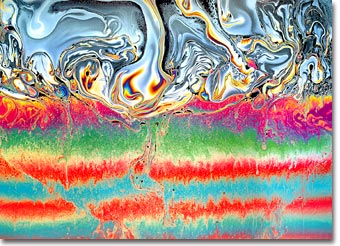Karl E. Deckart
Soap Bubble Gallery: Image Fifteen
German photographer and artist Karl E. Deckart is known for his thorough, precise, and beautiful work both in photography through the microscope and with macro camera systems. This gallery of interference photographs made with soap films is a testament to both Deckart's skill as a photographer and his understanding of the physical phenomena that surround our everyday lives. Presented below is soap bubble image number fifteen in small format. Click on the image to download a larger version.

|
Macrophotography of thin soap films freely suspended on a 4 x 4-inch wire frame was conducted with a Linhof large-format bellows camera system utilizing 4 x 5-inch sheet film and imaged using an apo-macro Nikon large format Nikkor-AM ED 210 mm f-5.6 lens. To prepare the soap film, equal parts of water, glycerin, and dishwasher detergent are thoroughly mixed in a container until a solution containing evenly sized micelles is achieved. A freestanding film is formed by dipping the wire frame into the solution and withdrawing carefully to maintain an even film thickness and avoid disruption of material flow across the frame rails. After suspension, the film was illuminated by a reflected light source positioned a few degrees from the camera system. The light was passed through a diffusion screen to avoid bright spots and provide an even illumination across the field. No polarizers were employed in photomacrography of soap thin films. Image ©1999 by Karl E. Deckart. All rights reserved. |
After the fall of the Roman Empire, soap making slowly evolved across Europe and was common in Italy and Spain during the 8th century. Until the thirteenth century, the primary ingredients in this universal cleaning agent continued to be goat fat and ashes from beech trees. The French, who were introduced to the art of soap making by Italians, devised a method to use olive oil in place of goat tallow. Fine soaps were favored by King James I, who granted special privileges to soap manufacturers a century after the practice took root in England during the 1500's. Continued experimentation by the Swedish and the French led to the discovery of glycerin, a syrupy sweet tasting liquid now used in such diverse products as soaps, cosmetics, antifreeze, heart medications, rocket fuel and explosives. Many of the finest soaps, however, continue to be made with the best tallow or food-grade animal fats.
BACK TO THE SOAP BUBBLE GALLERY
